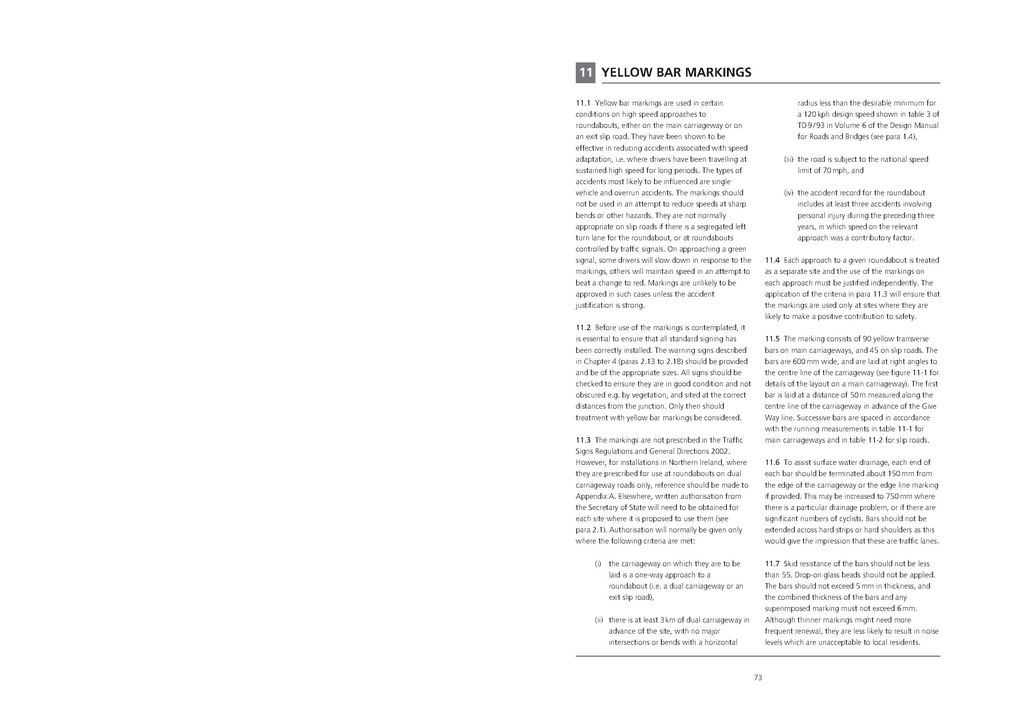11YELLOW BAR MARKINGS
11.1 Yellow bar markings are used in certain conditions on high speed approaches to roundabouts, either on the main carriageway or on an exit slip road. They have been shown to be effective in reducing accidents associated with speed adaptation, i.e. where drivers have been travelling at sustained high speed for long periods. The types of accidents most likely to be influenced are single vehicle and overrun accidents. The markings should not be used in an attempt to reduce speeds at sharp bends or other hazards. They are not normally appropriate on slip roads if there is a segregated left turn lane for the roundabout, or at roundabouts controlled by traffic signals. On approaching a green signal, some drivers will slow down in response to the markings, others will maintain speed in an attempt to beat a change to red. Markings are unlikely to be approved in such cases unless the accident justification is strong.
11.2 Before use of the markings is contemplated, it is essential to ensure that all standard signing has been correctly installed. The warning signs described in Chapter 4 (paras 2.13 to 2.18) should be provided and be of the appropriate sizes. All signs should be checked to ensure they are in good condition and not obscured e.g. by vegetation, and sited at the correct distances from the junction. Only then should treatment with yellow bar markings be considered.
11.3 The markings are not prescribed in the Traffic Signs Regulations and General Directions 2002. However, for installations in Northern Ireland, where they are prescribed for use at roundabouts on dual carriageway roads only, reference should be made to Appendix A. Elsewhere, written authorisation from the Secretary of State will need to be obtained for each site where it is proposed to use them (see para 2.1). Authorisation will normally be given only where the following criteria are met:
(i)the carriageway on which they are to be laid is a one-way approach to a roundabout (i.e. a dual carriageway or an exit slip road),
(ii) there is at least 3 km of dual carriageway in advance of the site, with no major intersections or bends with a horizontal radius less than the desirable minimum for a 120 kph design speed shown in table 3 of TD 9 / 93 in Volume 6 of the Design Manual for Roads and Bridges (see para 1.4),
(iii) the road is subject to the national speed limit of 70 mph, and
(iv) the accident record for the roundabout includes at least three accidents involving personal injury during the preceding three years, in which speed on the relevant approach was a contributory factor.
11.4 Each approach to a given roundabout is treated as a separate site and the use of the markings on each approach must be justified independently. The application of the criteria in para 11.3 will ensure that the markings are used only at sites where they are likely to make a positive contribution to safety.
11.5 The marking consists of 90 yellow transverse bars on main carriageways, and 45 on slip roads. The bars are 600 mm wide, and are laid at right angles to the centre line of the carriageway (see figure 11-1 for details of the layout on a main carriageway). The first bar is laid at a distance of 50 m measured along the centre line of the carriageway in advance of the Give Way line. Successive bars are spaced in accordance with the running measurements in table 11-1 for main carriageways and in table 11-2 for slip roads.
11.6 To assist surface water drainage, each end of each bar should be terminated about 150 mm from the edge of the carriageway or the edge line marking if provided. This may be increased to 750 mm where there is a particular drainage problem, or if there are significant numbers of cyclists. Bars should not be extended across hard strips or hard shoulders as this would give the impression that these are traffic lanes.
11.7 Skid resistance of the bars should not be less than 55. Drop-on glass beads should not be applied. The bars should not exceed 5 mm in thickness, and the combined thickness of the bars and any superimposed marking must not exceed 6 mm. Although thinner markings might need more frequent renewal, they are less likely to result in noise levels which are unacceptable to local residents.
73
